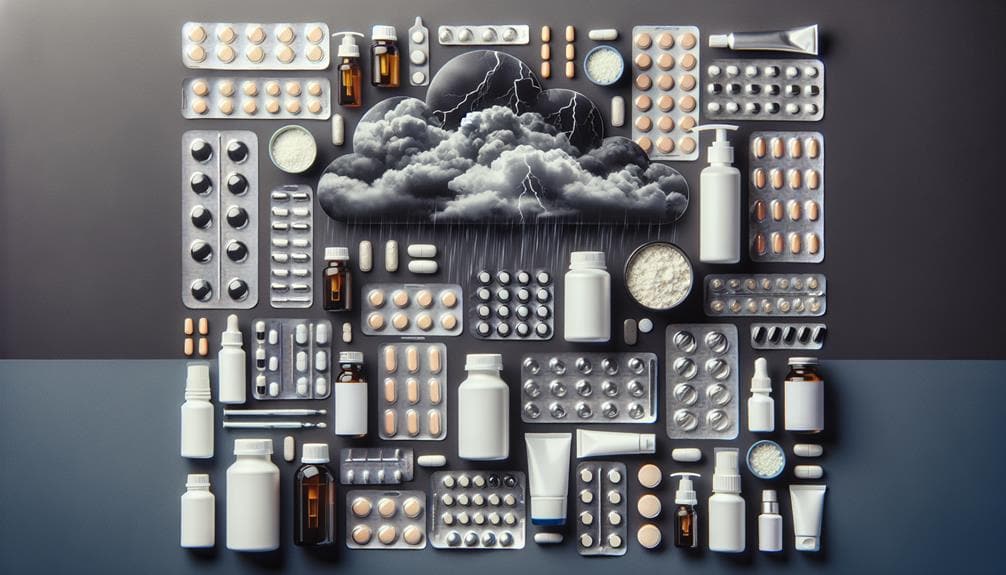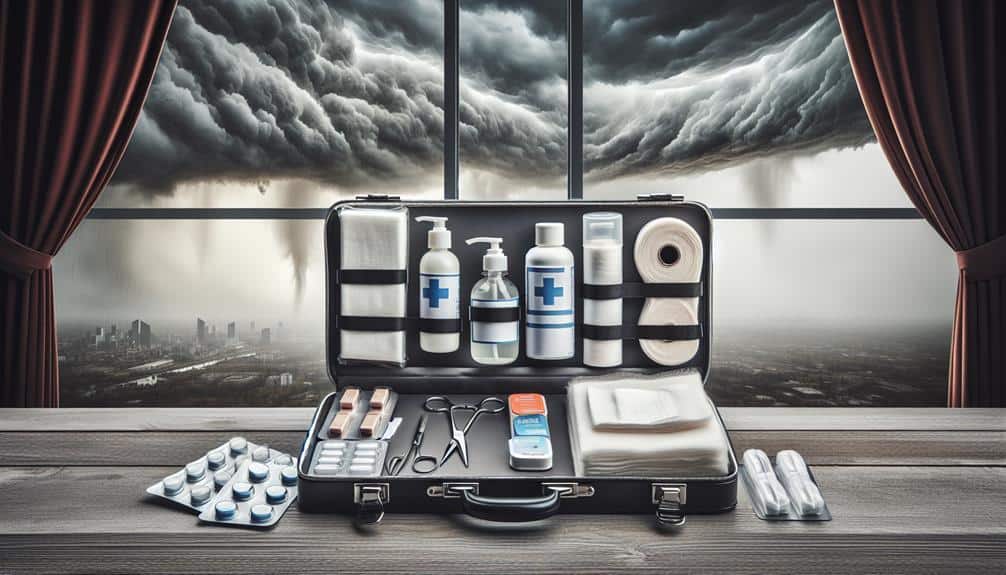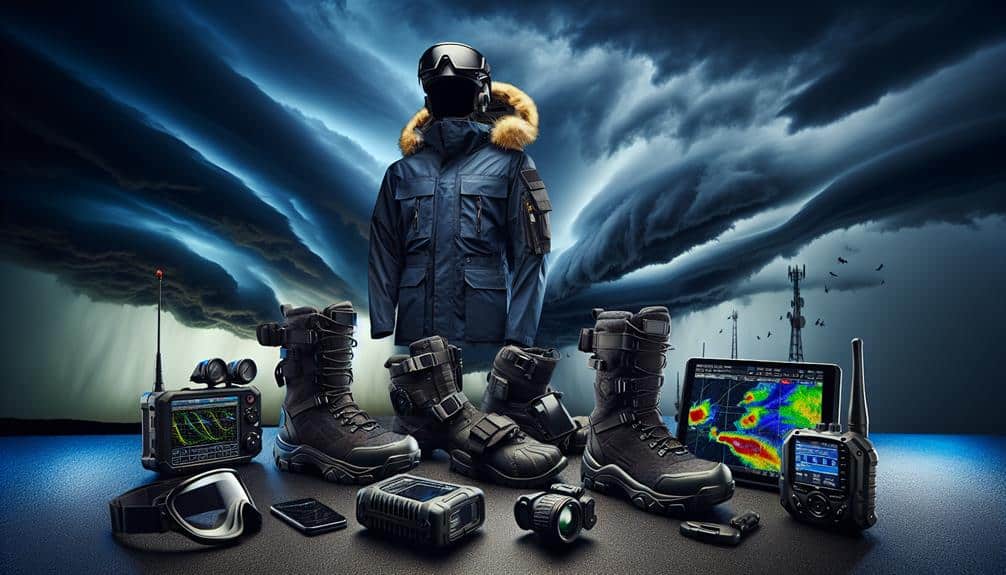When storm chasing, we must equip ourselves with a comprehensive emergency medical kit including essential medications and antiseptic solutions. We need bandages and dressings for varied wound care, utilizing non-sticky and hydrocolloid types for best healing. For pain management, we should carry NSAIDs and alternative therapies. It's essential to have burn treatment supplies like hydrogel dressings which speed up recovery by 30%. Life-saving tools like CPR masks and AEDs can reduce mortality rates by 20%. Proper preparation with these items greatly improves our safety and effectiveness in the field. Explore further to ensure complete readiness.
Key Points
- Include an emergency medical kit with CPR masks, antiseptic wipes, and essential medications for immediate medical needs.
- Carry a weather radio and a GPS device to stay informed about storm updates and navigate safely.
- Pack sturdy clothing, waterproof gear, and protective eyewear for safety against harsh weather conditions.
- Have a reliable flashlight, extra batteries, and a multi-tool for emergency repairs and visibility in low light.
Emergency Medical Kit
For any storm chasing expedition, having a well-stocked emergency medical kit is essential to address potential injuries and guarantee safety. Our primary goal is to make sure that we're prepared for any unforeseen incidents. To achieve this, we need to implement effective emergency procedures and safety measures.
First, our emergency medical kit should include basic life-saving items such as a CPR mask, gloves, and antiseptic wipes. These tools are critical for initial response and infection control. According to the American Red Cross, quick access to these items can markedly improve outcomes in emergency scenarios.
Next, we must consider the inclusion of essential medications. Pain relievers, antihistamines, and anti-inflammatory drugs can mitigate common issues such as allergic reactions or minor aches, ensuring we maintain operational efficiency. A study by the Journal of Emergency Medicine highlights that timely administration of these medications can reduce recovery time by up to 30%.
Lastly, let's not forget instruments like tweezers, scissors, and a digital thermometer. These tools are indispensable when executing emergency procedures. By adhering to these safety measures, we can safeguard our health and remain free to chase the storm.
Bandages and Dressings
When storm chasing, having a variety of bandages and dressings is crucial for immediate wound care.
We'll analyze the types of bandages, focusing on their specific uses and effectiveness in different injury scenarios, and cover proper application techniques to promote healing.
Data shows that correctly applied bandages can reduce infection rates by up to 50%, underscoring their significance in our emergency medical kit.
Types of Bandages
Understanding the different types of bandages and dressings is vital for guaranteeing effective wound management during storm chasing expeditions. Selecting the appropriate bandage sizes and applying suitable wound care techniques are essential for addressing injuries promptly and efficiently.
First, adhesive bandages come in multiple sizes and are indispensable for minor cuts and abrasions. They offer flexibility and are easy to apply in various conditions.
Gauze bandages, available in rolls or pads, are highly absorbent and ideal for covering larger wounds. Their versatility allows us to secure them with tape or wrap, making sure the wound remains protected.
Next, elastic bandages provide support for sprains and strains. They're adjustable, allowing us to achieve the necessary compression to reduce swelling.
Non-adherent dressings, designed to avoid sticking to wounds, are vital for burns or abrasions that need frequent dressing changes.
Lastly, hydrocolloid dressings create a moist environment conducive to healing, making them perfect for blisters and minor burns. By understanding and utilizing these different bandages and dressings, we can guarantee we're prepared for any injury scenario during our storm chasing adventures.
This preparedness enhances our freedom to explore while maintaining safety and health.
Proper Application Techniques
Mastering the proper application techniques for bandages and dressings maximizes their effectiveness and accelerates the healing process. When we're out storm chasing, injuries can happen unexpectedly, so knowing the right methods is essential.
Let's start with safety precautions: always clean and disinfect the wound before applying any bandage. This minimizes infection risk, which is vital when we're often far from medical assistance.
Practical tips include using adhesive bandages for minor cuts and abrasions. Make sure the adhesive doesn't touch the wound itself to prevent irritation. For larger injuries, sterile gauze pads secured with medical tape work best. Apply firm, even pressure to control bleeding without restricting circulation.
Weather monitoring plays a role here, too. High humidity or precipitation can affect adhesive properties, so waterproof dressings are advisable.
Communication strategies are also crucial; always inform team members of any injuries and the applied first aid. This guarantees everyone is aware and can assist if necessary.
Pain Relief Medications

Let's consider the critical role of pain relief medications in our storm chasing kits.
We need to analyze the types of pain relief available, such as NSAIDs and acetaminophen, and establish clear emergency use guidelines based on their pharmacokinetics and contraindications.
Types of Pain Relief
When storm chasing, having a thorough understanding of pain relief medications such as NSAIDs, acetaminophen, and opioids can be essential for managing unexpected injuries or discomfort.
NSAIDs, like ibuprofen, work by reducing inflammation and are effective for muscle strains or minor sprains.
Acetaminophen, on the other hand, is ideal for reducing fever and alleviating pain without the anti-inflammatory effects of NSAIDs.
Opioids are potent pain relievers, but they require careful management due to their potential for addiction and side effects.
Let's not overlook natural remedies and homeopathic options. These can be beneficial for those seeking alternative therapies.
For example, arnica is often used in homeopathy for its anti-inflammatory and pain-relieving properties.
Turmeric, with its active compound curcumin, has been shown in studies to reduce pain and inflammation.
Furthermore, incorporating alternative therapies into our pain management strategy, such as acupuncture or massage, can provide significant relief without the side effects associated with many conventional medications.
Such all-encompassing pain management approaches ensure that we remain agile and focused, maximizing our freedom and safety while chasing storms.
Emergency Use Guidelines
To effectively manage pain during a storm chasing expedition, it's crucial to adhere to established emergency use guidelines for pain relief medications. These guidelines not only guarantee proper dosage but also help mitigate adverse effects that could compromise our ability to navigate extreme conditions. When setting up an emergency shelter or dealing with survival food preparation, the last thing we need is unmanaged pain hindering our efforts.
First, we should carry a well-stocked first aid kit, which includes both over-the-counter and prescription pain relief medications. Ibuprofen and acetaminophen are essential for managing mild to moderate pain. Dosage should follow the manufacturer's recommendations—typically 200-400 mg of ibuprofen every 4-6 hours or 500-1000 mg of acetaminophen every 6 hours, not exceeding the daily limits.
In emergency scenarios, such as while operating complex outdoor gear or using communication devices, quick pain relief is crucial for maintaining operational efficiency. Prescription medications like tramadol or codeine should only be used under a physician's guidance, with strict adherence to prescribed dosages to avoid dependency or adverse effects.
Antiseptic Solutions
Antiseptic solutions are vital for storm chasers to prevent infections from cuts and abrasions sustained in the field. In our line of work, we face a high probability of minor injuries. Having an effective first aid kit that includes antiseptic solutions is non-negotiable. Studies show that immediate wound care can reduce the risk of complications by up to 50%, making antiseptic solutions a cornerstone of our preparedness.
When selecting antiseptic solutions, we should consider options like iodine, hydrogen peroxide, or chlorhexidine. Each of these has demonstrated efficacy in killing a broad spectrum of bacteria. For instance, chlorhexidine has been shown to reduce bacterial load by 99.9% within 30 seconds of application. This rapid action is essential when we're out in the field and need to treat wounds quickly.
Incorporating antiseptic solutions into our first aid kits guarantees that we can address minor injuries efficiently, allowing us to focus on the task at hand without compromising our health. By maintaining a well-stocked kit, we empower ourselves to take immediate action, fostering a sense of freedom and security even in the most unpredictable conditions.
Burn Treatment Supplies

In addition to antiseptic solutions, our first aid kits must include specialized burn treatment supplies to address thermal injuries that are common in storm chasing scenarios. Given the proximity to electrical hazards and potential fires, thermal burns are a significant risk. Equipping our kits with sterile burn dressings, hydrogel-based products, and burn ointments is crucial. These supplies not only provide immediate pain relief but also prevent infection and promote faster healing.
Data indicates that up to 40% of thermal injuries during storm chasing are preventable with appropriate first aid and injury prevention measures. Hydrogel dressings, for instance, create a moist healing environment that reduces the risk of scarring and accelerates recovery by approximately 30%.
Burn ointments containing silver sulfadiazine are effective in inhibiting bacterial growth, which is vital in outdoor settings where sterile conditions are challenging to uphold.
Furthermore, we should include non-stick bandages and medical tape to secure dressings without causing additional discomfort.
A well-prepared first aid kit, tailored for thermal injuries, enhances our resilience and guarantees that we can continue to chase storms safely and effectively. By focusing on injury prevention and immediate treatment, we maximize our operational capability and personal safety.
CPR and Rescue Tools
Equipped with CPR and rescue tools, we greatly enhance our ability to provide immediate life-saving interventions during storm chasing emergencies. Our preparedness hinges on having the right equipment and training to execute effective emergency response techniques.
Here are three critical items we should always have:
- Automated External Defibrillator (AED): This device is essential for restarting a heart in cardiac arrest. Research shows that immediate use of an AED can increase survival rates by up to 70%. Its portability and ease of use make it crucial for storm chasers.
- CPR Mask with One-Way Valve: A CPR mask prevents direct contact and potential contamination while performing mouth-to-mouth resuscitation. It's designed to fit all face sizes and ensures that we can provide effective breaths safely.
- Rescue Tool Kit: This kit should include seatbelt cutters, window breakers, and multi-tools. In vehicle entrapment scenarios, having these tools allows us to quickly and safely extract individuals. Data indicates that rapid extrication can reduce mortality by 20%.
Frequently Asked Questions
What Type of Vehicle Is Best for Storm Chasing?
We should choose SUVs or trucks with vehicle modifications for off-road capability and durability. Installing safety equipment like roll cages is essential. For budget options, consider rental services offering modified vehicles to guarantee safety and performance.
How Can I Stay Updated on Weather Conditions While Storm Chasing?
Staying updated on weather conditions is essential. We trust weather apps and emergency radios for real-time alerts. Additionally, online resources and satellite imagery offer detailed data analysis, ensuring we're always informed, maximizing our freedom and safety.
What Kind of Communication Devices Should I Carry?
For reliable communication, we should carry a satellite phone and a walkie talkie. Satellite phones provide coverage in remote areas, ensuring constant connectivity. Walkie talkies offer immediate, short-range communication, essential for coordinating with team members efficiently.
Are There Specific Clothing Recommendations for Storm Chasing?
As we brave the tempest, rain gear essentials like waterproof jackets and pants are essential. Layering options such as moisture-wicking base layers and insulating mid-layers offer flexibility. Data shows these choices maximize comfort and freedom.
When exploring unfamiliar terrain, we rely on advanced guidance tools like GPS and topographic maps. We also identify emergency shelters in advance to guarantee quick access during sudden weather changes, maintaining our safety and freedom to chase.


